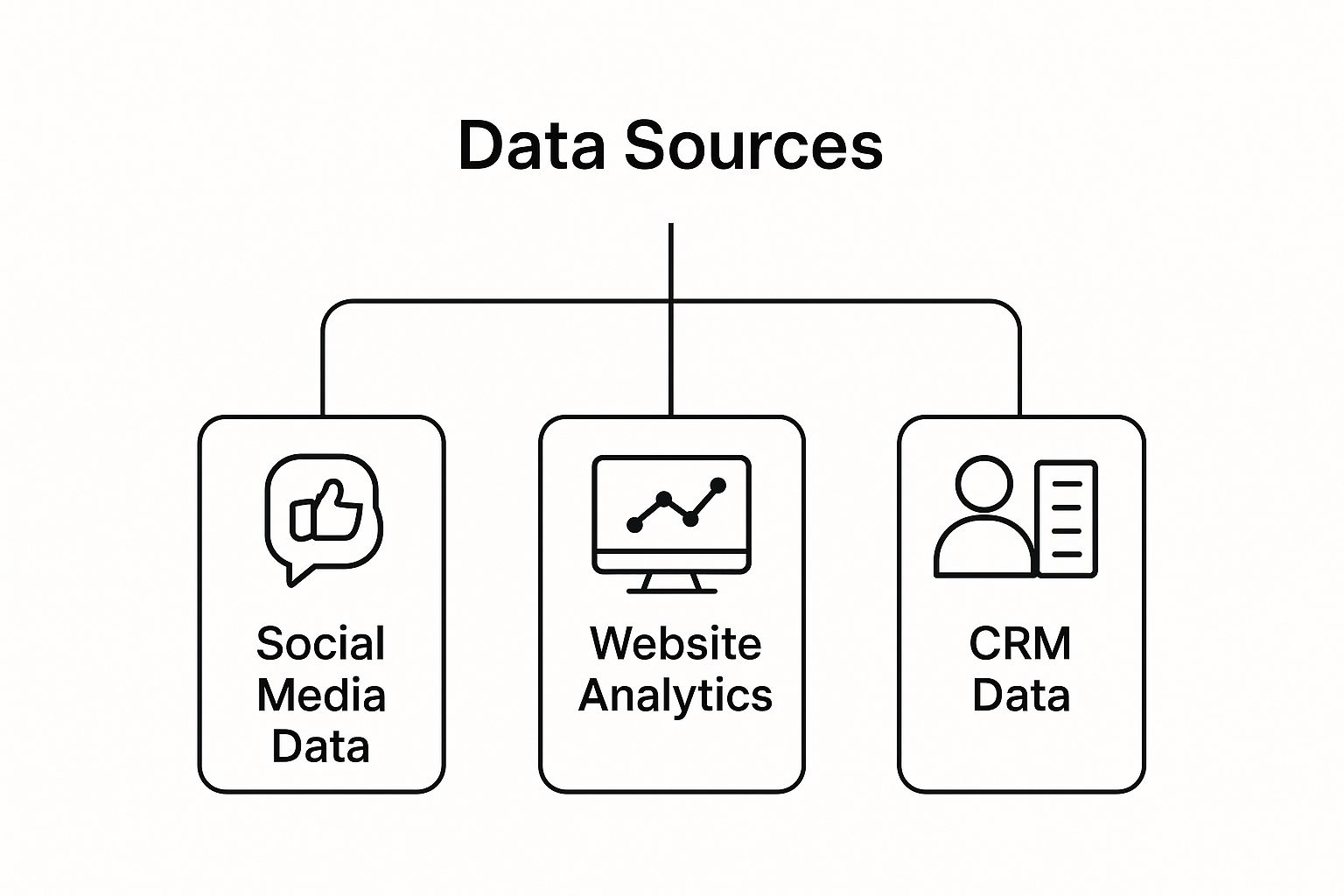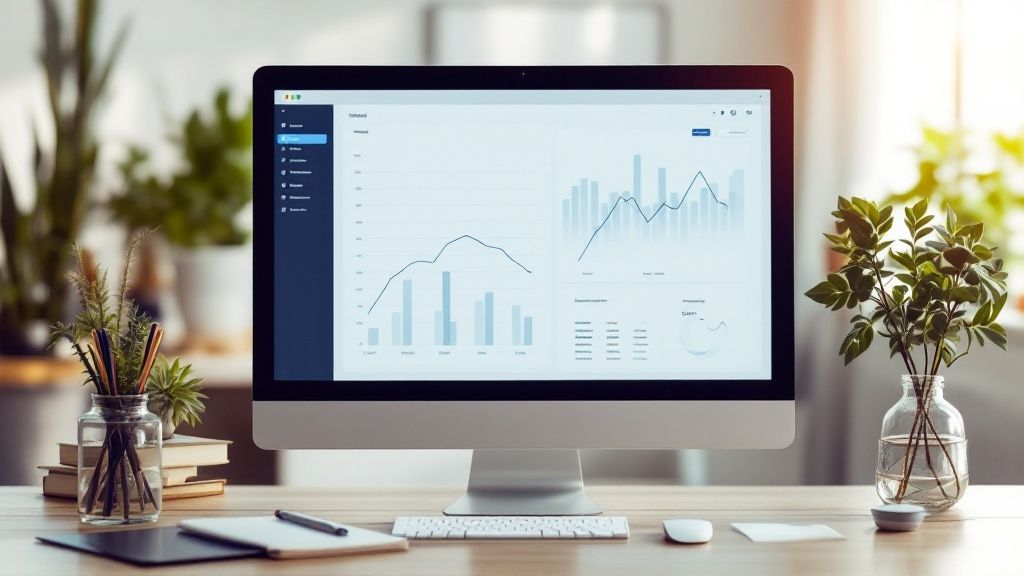What is a data driven marketing agency? Think of it as a strategic partner that relies on hard facts—customer data and analytics—instead of intuition. This approach replaces guesswork with a scientific process to fine-tune campaigns, create personalized experiences, and ultimately, secure the best possible return on investment (ROI). It's a fundamental shift from the old "creative-first" model of marketing.
Moving From Marketing Art To Data Science

Picture the classic 'Mad Men' era of advertising. It was a world fueled by big ideas, gut feelings, and raw creative instinct. A clever slogan or a bold ad could make a campaign, but measuring its true impact was nearly impossible. Fast-forward to today, where every click, view, and purchase tells a story.
This evolution represents the move from marketing as an art form to marketing as a science. Instead of just hoping an idea works, modern marketers have a flood of information that shows what actually works. A data-driven marketing agency stands at the center of this change, translating raw numbers into predictable business growth.
The Core Philosophy Of A Data Driven Agency
At its heart, a data-driven approach is about making decisions based on evidence. It’s the difference between crossing your fingers for a campaign to succeed and engineering it for success from the start. This philosophy is built on a constant cycle of testing, learning, and optimizing.
Key principles guide this approach:
- Measurement Over Assumption: Every strategy is tied to specific Key Performance Indicators (KPIs) that directly link to business goals, such as customer acquisition cost or lifetime value.
- Personalization at Scale: Data provides a deep understanding of different customer groups, enabling tailored messages that resonate with individual needs and behaviors.
- Predictive Insight: Advanced analytics don't just report on past performance. They help forecast future trends and customer actions, allowing you to make strategic adjustments before falling behind.
This methodical approach is becoming the industry standard. The global digital marketing agency market generated approximately $598.58 billion and is projected to reach $1,443.27 billion by 2034, growing at a compound annual rate of 9.2%. This boom illustrates how many businesses are embracing data-powered digital strategies.
The ultimate goal is to move beyond simply running campaigns and start building a systematic engine for customer acquisition and retention. It's about turning marketing from a cost center into a predictable revenue driver.
When you partner with a data driven marketing agency, you can stop guessing what your customers want and start giving them exactly what the data shows they need. This precision doesn't just boost campaign performance; it builds stronger, more profitable customer relationships over the long haul. You can learn more about how to implement these data-driven marketing solutions to transform your own strategies.
The Four Pillars of A Data-Driven Strategy
An expert data-driven marketing agency doesn’t just throw tactics at a wall to see what sticks. They build their strategies on a solid, interconnected foundation.
Think of it like building a house. You need a solid blueprint (strategy), quality materials (data), skilled builders (analytics), and ongoing improvements (optimization). This structure is held up by four essential pillars that work in a continuous cycle.
Each pillar flows logically into the next, creating a loop of constant improvement. It begins with gathering the right raw materials and ends with turning those materials into tangible campaign enhancements that drive business growth. This systematic process ensures every marketing dollar is spent with a clear purpose and a measurable goal.
Pillar 1: Data Collection
Everything begins with gathering the right information. This isn't about hoarding every byte of data available; it's about focusing on the metrics that directly impact your business goals. This pillar is the bedrock, providing the raw materials for everything that follows.
A smart agency pulls from multiple sources to build a complete, 360-degree view of the customer journey. This typically involves blending first-party data (information you own, like website interactions and CRM data) with third-party data (broader market and demographic insights). The end goal is to create a single, unified picture of customer behavior.
This image shows the main data streams a modern agency integrates.

By weaving together insights from social media, website analytics, and CRM systems, agencies can see past surface-level numbers to truly understand the entire customer lifecycle.
Pillar 2: Advanced Analytics
Once the data is collected, the real work begins: making sense of it all. This is where a data-driven marketing agency proves its value, moving beyond simple reports to unearth deep, actionable insights. Advanced analytics is about finding the "why" behind the "what"—spotting patterns, connections, and trends that aren’t immediately obvious.
For example, analytics might reveal that customers who read a specific blog post are 40% more likely to make a purchase within a week. That's infinitely more valuable than knowing the post got 10,000 views. It's a direct line connecting a marketing activity to revenue. You can explore different customer segmentation strategies that help turn raw data into profitable audience groups.
Pillar 3: Strategic Forecasting
While analytics tells you what happened, strategic forecasting uses that history to predict what is likely to happen next. This is the pivot from reactive marketing to proactive strategy. You stop responding to market changes and start anticipating them.
Strategic forecasting isn't about gazing into a crystal ball. It’s about using predictive models to map out future opportunities and risks. This allows you to allocate resources and plan campaigns more intelligently—often long before your competitors know what's coming.
Let's say an agency analyzes seasonal search trends and past purchase data. They can then predict which products are likely to be popular next quarter. This gives the business a significant head start to adjust inventory, prepare marketing campaigns, and optimize ad spend to capture demand while others are still playing catch-up.
Pillar 4: Actionable Optimization
The final pillar is where insight meets execution. Insights and forecasts are merely interesting theories if they don’t lead to tangible improvements. Actionable optimization is the process of turning data-backed conclusions into concrete changes in your marketing campaigns.
This isn’t a one-time fix; it’s a continuous feedback loop:
- Test: An insight sparks a hypothesis. For example, "Changing our ad copy to highlight a specific feature will boost click-through rates."
- Measure: The agency runs an A/B test to measure the new version's impact against the original.
- Learn: The results are analyzed to determine if the hypothesis was correct. Did it work? Why or why not?
- Implement: If the test succeeds, the winning change is rolled out across all relevant campaigns.
This cycle ensures your marketing efforts are constantly evolving based on hard performance data, not just gut feelings. It's this commitment to steady, iterative improvement that drives sustainable, long-term results.
How AI Powers Modern Marketing Agencies

If data is the fuel for a modern marketing agency, then Artificial Intelligence (AI) is the high-performance engine. AI gives agencies the power to process massive datasets, spot patterns a human would miss, and deploy strategies with a speed and precision that was science fiction just a few years ago. It’s the difference between a good strategy and an unbeatable one.
Think of AI as a brilliant analyst who can sift through millions of customer interactions in seconds. While a human team might notice a broad trend over a month, an AI can flag a micro-trend in real-time—like a sudden spike in interest for a product feature or an ad that’s starting to underperform. This is what lets a data driven marketing agency get ahead of the curve instead of just reacting to it.
AI is no longer a futuristic concept; it's a practical tool that automates complex tasks, predicts outcomes, and delivers personalized experiences at scale, providing a serious competitive edge.
Unlocking Hyper-Personalization at Scale
One of AI's most powerful applications is creating deeply personal experiences for thousands, or even millions, of customers simultaneously. Traditional marketing often groups people into broad segments like "males aged 25-34." AI goes much deeper, analyzing individual behavior to understand exactly what each person wants.
For instance, an e-commerce site can use AI to analyze a shopper's entire history—what they've clicked, what they've bought, and even how long they lingered on a particular product. The AI then instantly generates product recommendations, email offers, and social media ads that feel uniquely tailored to them. This marks a complete shift from broad segmentation to true one-to-one marketing.
Predictive Bidding and Budget Optimization
Wasted ad spend is the silent killer of many marketing budgets. AI tackles this problem with predictive bidding. Instead of setting a fixed bid for an ad, AI models analyze countless signals in real time—time of day, user location, device type—to predict a user's likelihood to convert.
This means the system can automatically bid more for a high-intent user and less for someone who is just browsing. This dynamic approach ensures every dollar of the ad budget is spent as efficiently as possible, reducing customer acquisition costs and boosting ROI. Best of all, the AI is always learning, becoming smarter and more effective every day.
AI's ability to forecast outcomes is what truly separates a modern data driven marketing agency from the rest. It’s not just about analyzing past performance; it's about using that data to make smarter, more profitable decisions about the future.
The market is exploding due to this impact. The AI marketing industry reached a value of about $47.32 billion, a massive leap from $12.05 billion in 2020. With forecasts predicting it will more than double to $107.5 billion by 2028, it’s clear that AI is now a core component of modern marketing.
Discovering Hidden Consumer Trends
Tucked away in massive datasets are subtle consumer trends that are almost impossible for a person to see. AI-powered tools can analyze social media conversations, product reviews, and website search queries to pinpoint emerging patterns and shifts in consumer sentiment.
- Sentiment Analysis: AI can interpret the emotional tone behind customer comments, helping brands gauge public perception and address issues proactively.
- Topic Clustering: It groups related conversations, revealing what topics are gaining traction or which new product features customers are requesting.
- Predictive Lead Scoring: For B2B companies, AI analyzes a lead's behavior to score their purchase readiness, allowing sales teams to focus on the most promising prospects.
By unearthing these insights, a data driven marketing agency helps its clients anticipate market shifts, build more relevant products, and create content that genuinely connects with their audience. To see more of what AI can do, our guide on what AI in marketing means for businesses breaks it down further. AI is no longer a buzzword—it's the operational backbone of high-performance marketing.
Key Services A Data Driven Agency Offers
Partnering with a data driven marketing agency is less about a checklist of services and more about how each tactic is informed by real insights. Every decision is backed by data, leading to campaigns that reach the right audience at the right time and produce measurable business outcomes.
Instead of standard “SEO” or generic “paid ads,” a data-driven agency employs advanced techniques like predictive SEO and programmatic advertising to target individuals, not just demographics. This precision results in lower acquisition costs, higher customer lifetime value, and a steady stream of qualified leads.
Predictive SEO And Content Strategy
Traditional SEO often reacts to existing keyword trends. Predictive SEO flips that script. By analyzing data to forecast which topics will become popular next, your content can go live ahead of the competition, securing prime real estate in search results.
Key data sources for this include:
- Historical Search Data to identify seasonal and year-over-year trends.
- Social Listening Tools to catch early conversations around emerging topics.
- Competitor Gap Analysis to reveal underserved keywords you can own.
When you publish content on a term just as interest is spiking, your brand becomes an authoritative voice. This proactive approach builds domain authority and cements your position as an industry leader.
Programmatic Advertising And Media Buying
Broad paid-ad campaigns can feel like casting a wide net and hoping for the best. Programmatic advertising is more like a guided missile: it uses real-time bidding to target individuals based on their online behavior.
Instead of hoping the right people see your ad, programmatic technology buys ad impressions for the specific user most likely to convert, across thousands of websites and apps.
This hyper-targeting relies on signals such as:
- Browsing history
- Past purchase patterns
- Demographic and psychographic profiles
- Location and device data
The result is a significant boost in ROI and a drastic reduction in wasted ad spend.
Advanced Customer Analytics And Segmentation
While many agencies stop at basic demographics, a data-driven partner dives deeper. They integrate CRM records, website analytics, and sales history into a unified customer view. From there, they can:
- Identify your most profitable customer segments.
- Pinpoint the key triggers that lead to a purchase.
- Predict which customers are at risk of churning.
These insights power highly personalized campaigns, from email sequences that address individual pain points to special offers timed for maximum impact.
Conversion Rate Optimization (CRO)
Bringing visitors to your site is only half the battle. Turning them into customers is where CRO makes a difference. A data driven marketing agency treats your website like a laboratory, running constant experiments to maximize the value of every visit.
Their CRO cycle typically involves:
- Data Analysis: Using heatmaps, session recordings, and funnel reports to identify drop-off points.
- Hypothesis Creation: For example, “Moving the ‘Book a Demo’ button above the fold will increase form submissions by 15%.”
- A/B Testing: Splitting traffic between different versions to measure performance uplift.
- Implementation & Iteration: Rolling out the winning version and repeating the process.
Every change is backed by hard numbers, ensuring your site becomes progressively more effective. Insights from CRO also reveal patterns in user behavior that can inform your broader strategy, a concept we explore in our guide to marketing automation implementation.
By combining these core services—predictive SEO, programmatic advertising, deep analytics, and rigorous CRO—a data-driven agency doesn’t just complete tasks; it drives growth. Each tactic connects to the next, creating a self-reinforcing cycle of insight, action, and improvement.
How to Choose the Right Agency Partner

Selecting the right partner is the most critical decision you'll make on your data-driven journey. The right choice can be a force multiplier for your growth, while the wrong one can lead to wasted budgets and missed opportunities.
This isn't just about hiring a vendor; it's about finding a strategic ally who understands your business goals and has the technical expertise to achieve them. To do that, you need to look past slick presentations and ask the tough questions that reveal their true capabilities. A great data driven marketing agency will welcome this scrutiny.
Evaluating Their Technology Stack
An agency’s tools are the engine behind its analytical power. An outdated or fragmented tech stack is like trying to build a skyscraper with hand tools—you'll never achieve the necessary precision or scale. You need to look under the hood to see what’s powering their insights.
When speaking with a potential agency, get specific about their technology:
- Data Integration: How do they consolidate scattered data from your CRM, ad platforms, and website analytics into a single, unified view?
- Analytics Platforms: What are their primary tools for analysis and visualization? Are they experts in platforms like Google Analytics 4, Adobe Analytics, or Tableau?
- Automation Tools: What platforms do they use to execute automated campaigns and workflows? Look for experience with tools like HubSpot, Marketo, or ActiveCampaign.
Their answers will reveal their technical maturity. If they can’t explain a clear process for unifying data or rely solely on basic reports, they may lack the depth needed to tackle complex challenges.
Assessing Analytical Expertise and Strategy
Having the best tools is meaningless without smart people who can interpret the data and turn it into a winning strategy. This is where you separate the data reporters from the true data strategists.
A great partner doesn’t just deliver charts; they tell you the story behind the numbers and, most importantly, recommend what to do next.
A major red flag is an agency that focuses on vanity metrics like impressions or social media likes. A true partner ties every action back to core business outcomes, such as Customer Acquisition Cost (CAC), Lifetime Value (LTV), and Return on Ad Spend (ROAS).
To test their strategic thinking, put them on the spot:
- Give Them a Business Problem: Present a real-world scenario, like, "Our lead quality has dropped by 20%." Ask them how they would use data to diagnose the cause.
- Ask for Real Case Studies: Don't settle for vague success stories. Push for case studies with specific numbers, such as, "We reduced their CPA by 30% in six months by reallocating ad spend based on predictive modeling."
- Inquire About the Team: Who, specifically, will be working on your account? What are their qualifications in data science, analytics, and marketing strategy?
This line of questioning cuts through the sales pitch and gets to the core of their capabilities.
Demanding Reporting Transparency
Transparency is non-negotiable. You need a clear, real-time view of your investment's performance. Any top-tier data driven marketing agency will provide custom dashboards that give you direct access to the metrics that matter to your business.
Before signing a contract, get concrete answers on reporting:
- What will our dashboards show, and how often will they be updated?
- How frequently will we have strategy meetings to review performance and plan next steps?
- How do you report on both successes and failures?
With global marketing spend expected to hit around $1.7 trillion—and digital marketing accounting for an estimated 65% of that—you can't afford to be left in the dark. You can discover more market marketing statistics that highlight why a transparent, effective partner is so critical to your bottom line.
A great agency isn't afraid to show you the whole picture, good or bad, because they are confident in their ability to drive the results that matter.
Still Have a Few Questions? Let's Clear Them Up.
Even when the strategy makes sense, embracing a data-first approach can bring up practical questions. Businesses often wonder about real-world costs, timelines, and what they need to provide to partner with a data driven marketing agency.
This section serves as a final pre-flight check, offering straight answers to the most common concerns so you can move forward with confidence.
How Much Does a Data-Driven Marketing Agency Cost?
The investment varies significantly based on the scope of work, your company's complexity, and the agency's expertise. While there's no single price tag, pricing is typically structured in a few common ways:
- Monthly Retainers: The most common model, where you pay a fixed fee each month for ongoing services like SEO, content strategy, and campaign management. This provides predictable budgeting.
- Project-Based Fees: For one-off projects like a website overhaul or a deep-dive data audit, agencies will quote a flat fee for the specific engagement.
- Performance-Based Fees: Some agencies tie a portion of their fee directly to hitting specific goals, such as generating a certain number of qualified leads or reaching a target ROAS. This model aligns their success directly with yours.
A small business might start with an investment of a few thousand dollars a month for foundational services. Conversely, a large enterprise with complex, multi-channel campaigns could invest six figures monthly. The key is to find a partner with transparent pricing that clearly connects your investment to expected business outcomes.
What Data Do I Need to Give an Agency?
Many business owners worry their data isn't "good enough." The truth is, no one's data is perfect. A skilled data driven marketing agency doesn't expect perfection—their job is to help you build a stronger data foundation.
To start, an agency typically needs access to your core digital platforms to understand your current performance. This usually includes:
- Website Analytics: Access to your Google Analytics 4 account is essential.
- Customer Relationship Management (CRM): Access to your CRM (like Salesforce or HubSpot) reveals insights about your sales pipeline.
- Advertising Accounts: They'll need access to platforms like Google Ads and Meta Ads to analyze campaign performance.
A great partner won't judge your existing data; they'll begin with a thorough audit to assess what you have. From there, they will build a strategy to improve tracking, clean up historical information, and enrich your datasets to create a clearer picture of your customers.
The goal isn't to start with perfection. It's to build a reliable data foundation, together.
How Long Until We See Results?
This depends on the channels being used. It's helpful to think about results in two categories: short-term wins and long-term momentum.
You can often see positive indicators within the first 1-3 months. These early wins typically come from optimizing paid ad campaigns or running A/B tests on key landing pages. For instance, reallocating ad spend based on initial performance data can quickly lower your cost per acquisition.
However, truly transformative growth comes from long-term strategies. The compounding value from initiatives like predictive SEO or authority-building content marketing often takes 6-12 months to gain significant traction. A trustworthy agency will provide a clear roadmap with both short-term benchmarks and long-term KPIs, allowing you to track progress every step of the way. It's also crucial to understand how different touchpoints contribute to a conversion, a topic we explore in our guide on what is marketing attribution.
Is a Data-Driven Agency a Good Fit for a Small Business?
Absolutely. In fact, small and mid-sized businesses often have the most to gain. With a limited budget, every dollar must be effective. A data-driven strategy eliminates guesswork and focuses your resources on the activities that deliver the biggest impact.
For a smaller business, a data-driven approach allows you to:
- Find Your Most Profitable Niche: Instead of trying to appeal to everyone, data helps you identify and target your ideal customer segments.
- Maximize a Limited Budget: By understanding which channels deliver the best return, you can allocate your marketing spend with surgical precision.
- Compete with Bigger Players: You may not have a corporate-sized budget, but data enables you to be smarter and more agile, creating hyper-relevant campaigns that resonate deeply with a specific audience.
A nimble data driven marketing agency can scale its services to fit your budget, focusing on foundational tracking and high-impact channels first. This generates measurable growth that you can then reinvest into your marketing.
At Twelverays, we specialize in crafting data-driven strategies that turn insights into revenue. If you're ready to move beyond guesswork and build a predictable engine for growth, let's talk.





